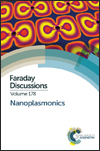Ultrafast dynamics of nanoplasmonic stopped-light lasing
Abstract
We study the spatio-temporal dynamics of coherent amplification and lasing in planar gain-enhanced nanoplasmonic structures and show that a singularity in the density of optical states leads to a stopped-light feedback mechanism that allows for cavity-free photonic and surface-plasmon polariton nanolasing. We reveal that in the absence of cavity-induced feedback a phase-locked superposition of a quasi dispersion-free waveguide mode promotes the dynamic formation of a subwavelength lasing mode. Simulations on the basis of a full-time domain Maxwell–Bloch Langevin approach uncover a high spontaneous emission factor β ≈ 0.9 and demonstrate that the stopped-light lasing/spasing mechanism is remarkably robust against interface roughness. Stopped-light surface-plasmon polariton lasing is shown to be stable for gain sections of a width of down to 200 nm but in wider gain structures of the order of 1 μm the dynamics is characterised by spatio-temporally oscillating lasing surface-plasmon polaritons with typical temporal and spatial periods of smaller than 5 fs and smaller than 100 nm. Stopped-light lasing thus provides opportunities for ultrafast nanolasing and the realization of ultra-thin lasing surfaces and offers a new route to ultrafast spasing and cavity-free active quantum plasmonics.
- This article is part of the themed collection: Nanoplasmonics

 Please wait while we load your content...
Please wait while we load your content...